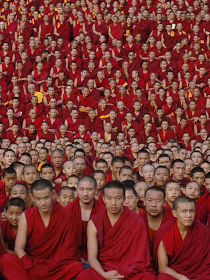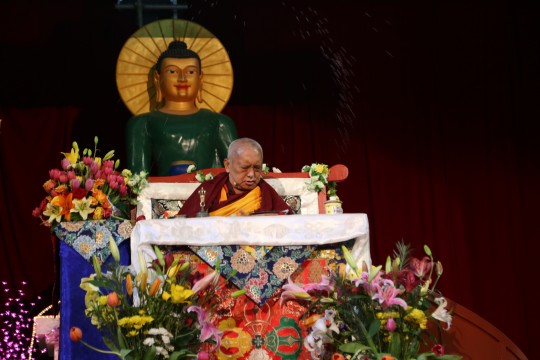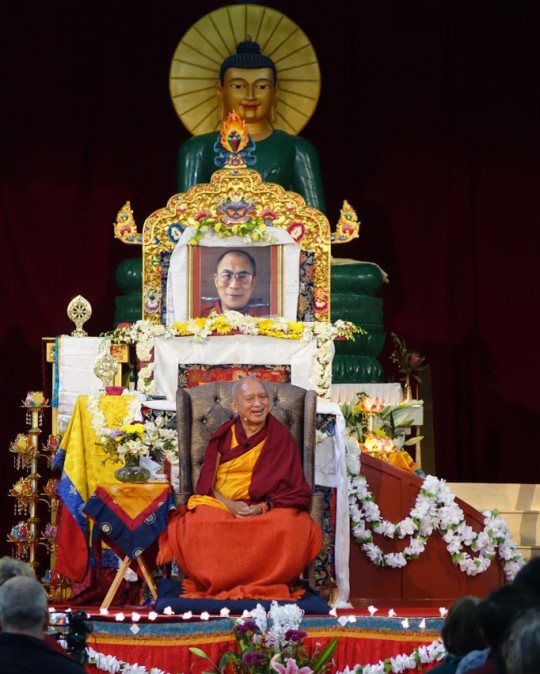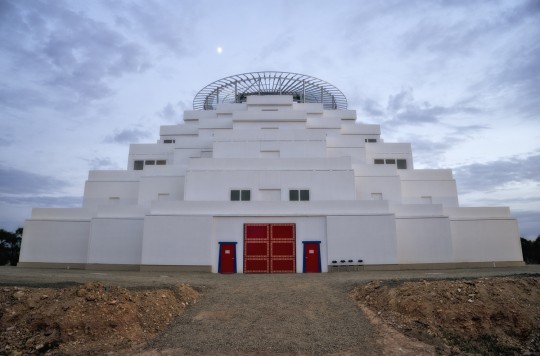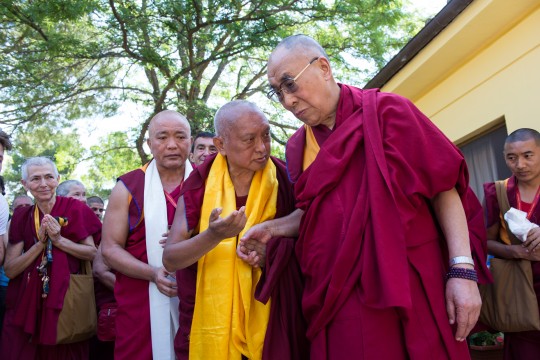- Home
- FPMT Homepage
Foundation for the Preservation of the Mahayana Tradition
The FPMT is an organization devoted to preserving and spreading Mahayana Buddhism worldwide by creating opportunities to listen, reflect, meditate, practice and actualize the unmistaken teachings of the Buddha and based on that experience spreading the Dharma to sentient beings. We provide integrated education through which people’s minds and hearts can be transformed into their highest potential for the benefit of others, inspired by an attitude of universal responsibility and service. We are committed to creating harmonious environments and helping all beings develop their full potential of infinite wisdom and compassion. Our organization is based on the Buddhist tradition of Lama Tsongkhapa of Tibet as taught to us by our founders Lama Thubten Yeshe and Lama Thubten Zopa Rinpoche.
- Willkommen
Die Stiftung zur Erhaltung der Mahayana Tradition (FPMT) ist eine Organisation, die sich weltweit für die Erhaltung und Verbreitung des Mahayana-Buddhismus einsetzt, indem sie Möglichkeiten schafft, den makellosen Lehren des Buddha zuzuhören, über sie zur reflektieren und zu meditieren und auf der Grundlage dieser Erfahrung das Dharma unter den Lebewesen zu verbreiten.
Wir bieten integrierte Schulungswege an, durch denen der Geist und das Herz der Menschen in ihr höchstes Potential verwandelt werden zum Wohl der anderen – inspiriert durch eine Haltung der universellen Verantwortung und dem Wunsch zu dienen. Wir haben uns verpflichtet, harmonische Umgebungen zu schaffen und allen Wesen zu helfen, ihr volles Potenzial unendlicher Weisheit und grenzenlosen Mitgefühls zu verwirklichen.
Unsere Organisation basiert auf der buddhistischen Tradition von Lama Tsongkhapa von Tibet, so wie sie uns von unseren Gründern Lama Thubten Yeshe und Lama Thubten Zopa Rinpoche gelehrt wird.
- Bienvenidos
La Fundación para la preservación de la tradición Mahayana (FPMT) es una organización que se dedica a preservar y difundir el budismo Mahayana en todo el mundo, creando oportunidades para escuchar, reflexionar, meditar, practicar y actualizar las enseñanzas inconfundibles de Buda y en base a esa experiencia difundir el Dharma a los seres.
Proporcionamos una educación integrada a través de la cual las mentes y los corazones de las personas se pueden transformar en su mayor potencial para el beneficio de los demás, inspirados por una actitud de responsabilidad y servicio universales. Estamos comprometidos a crear ambientes armoniosos y ayudar a todos los seres a desarrollar todo su potencial de infinita sabiduría y compasión.
Nuestra organización se basa en la tradición budista de Lama Tsongkhapa del Tíbet como nos lo enseñaron nuestros fundadores Lama Thubten Yeshe y Lama Zopa Rinpoche.
A continuación puede ver una lista de los centros y sus páginas web en su lengua preferida.
- Bienvenue
L’organisation de la FPMT a pour vocation la préservation et la diffusion du bouddhisme du mahayana dans le monde entier. Elle offre l’opportunité d’écouter, de réfléchir, de méditer, de pratiquer et de réaliser les enseignements excellents du Bouddha, pour ensuite transmettre le Dharma à tous les êtres. Nous proposons une formation intégrée grâce à laquelle le cœur et l’esprit de chacun peuvent accomplir leur potentiel le plus élevé pour le bien d’autrui, inspirés par le sens du service et une responsabilité universelle. Nous nous engageons à créer un environnement harmonieux et à aider tous les êtres à épanouir leur potentiel illimité de compassion et de sagesse. Notre organisation s’appuie sur la tradition guéloukpa de Lama Tsongkhapa du Tibet, telle qu’elle a été enseignée par nos fondateurs Lama Thoubtèn Yéshé et Lama Zopa Rinpoché.
Visitez le site de notre Editions Mahayana pour les traductions, conseils et nouvelles du Bureau international en français.
Voici une liste de centres et de leurs sites dans votre langue préférée
- Benvenuto
L’FPMT è un organizzazione il cui scopo è preservare e diffondere il Buddhismo Mahayana nel mondo, creando occasioni di ascolto, riflessione, meditazione e pratica dei perfetti insegnamenti del Buddha, al fine di attualizzare e diffondere il Dharma fra tutti gli esseri senzienti.
Offriamo un’educazione integrata, che può trasformare la mente e i cuori delle persone nel loro massimo potenziale, per il beneficio di tutti gli esseri, ispirati da un’attitudine di responsabilità universale e di servizio.
Il nostro obiettivo è quello di creare contesti armoniosi e aiutare tutti gli esseri a sviluppare in modo completo le proprie potenzialità di infinita saggezza e compassione.
La nostra organizzazione si basa sulla tradizione buddhista di Lama Tsongkhapa del Tibet, così come ci è stata insegnata dai nostri fondatori Lama Thubten Yeshe e Lama Zopa Rinpoche.
Di seguito potete trovare un elenco dei centri e dei loro siti nella lingua da voi prescelta.
- 欢迎 / 歡迎
简体中文
“护持大乘法脉基金会”( 英文简称:FPMT。全名:Foundation for the Preservation of the Mahayana Tradition) 是一个致力于护持和弘扬大乘佛法的国际佛教组织。我们提供听闻,思维,禅修,修行和实证佛陀无误教法的机会,以便让一切众生都能够享受佛法的指引和滋润。
我们全力创造和谐融洽的环境, 为人们提供解行并重的完整佛法教育,以便启发内在的环宇悲心及责任心,并开发内心所蕴藏的巨大潜能 — 无限的智慧与悲心 — 以便利益和服务一切有情。
FPMT的创办人是图腾耶喜喇嘛和喇嘛梭巴仁波切。我们所修习的是由两位上师所教导的,西藏喀巴大师的佛法传承。
繁體中文
護持大乘法脈基金會”( 英文簡稱:FPMT。全名:Found
ation for the Preservation of the Mahayana Tradition ) 是一個致力於護持和弘揚大乘佛法的國際佛教組織。我們提供聽聞, 思維,禪修,修行和實證佛陀無誤教法的機會,以便讓一切眾生都能 夠享受佛法的指引和滋潤。 我們全力創造和諧融洽的環境,
為人們提供解行並重的完整佛法教育,以便啟發內在的環宇悲心及責 任心,並開發內心所蘊藏的巨大潛能 — 無限的智慧與悲心 – – 以便利益和服務一切有情。 FPMT的創辦人是圖騰耶喜喇嘛和喇嘛梭巴仁波切。
我們所修習的是由兩位上師所教導的,西藏喀巴大師的佛法傳承。 察看道场信息:
- FPMT Homepage
- News/Media
-
- Study & Practice
-
-
- About FPMT Education Services
- Latest News
- Programs
- New to Buddhism?
- Buddhist Mind Science: Activating Your Potential
- Heart Advice for Death and Dying
- Discovering Buddhism
- Living in the Path
- Exploring Buddhism
- FPMT Basic Program
- FPMT Masters Program
- FPMT In-Depth Meditation Training
- Maitripa College
- Lotsawa Rinchen Zangpo Translator Program
- Universal Education for Compassion & Wisdom
- Online Learning Center
-
- Prayers & Practice Materials
- Overview of Prayers & Practices
- Full Catalogue of Prayers & Practice Materials
- Explore Popular Topics
- Benefiting Animals
- Chenrezig Resources
- Death & Dying Resources
- Lama Chopa (Guru Puja)
- Lama Zopa Rinpoche: Compendium of Precious Instructions
- Lama Zopa Rinpoche: Life Practice Advice
- Lama Zopa Rinpoche Practice Series
- Lamrim Resources
- Mantras
- Prayer Book Updates
- Purification Practices
- Sutras
- Thought Transformation (Lojong)
- Audio Materials
- Dharma Dates - Tibetan Calendar
- Translation Services
- Publishing Services
- Ways to Offer Support
- Prayers & Practice Materials
-
- Teachings and Advice
- Find Teachings and Advice
- Lama Zopa Rinpoche Advice Page
- Lama Zopa Rinpoche: Compendium of Precious Instructions
- Lama Zopa Rinpoche Video Teachings
- ༧སྐྱབས་རྗེ་བཟོད་པ་རིན་པོ་ཆེ་མཆོག་ནས་སྩལ་བའི་བཀའ་སློབ་བརྙན་འཕྲིན།
- Podcasts
- Lama Yeshe Wisdom Archive
- Buddhism FAQ
- Dharma for Young People
- Resources on Holy Objects
- Teachings and Advice
-
-
*If a menu item has a submenu clicking once will expand the menu clicking twice will open the page.
-
-
- Centers
-
- Teachers
-
- Projects
-
-
-
-
*If a menu item has a submenu clicking once will expand the menu clicking twice will open the page.
-
-
- FPMT
-
-
-
-
-
For happiness, cherish others.
Lama Zopa Rinpoche
-
-
-
- Shop
-
-
-
The Foundation Store is FPMT’s online shop and features a vast selection of Buddhist study and practice materials written or recommended by our lineage gurus. These items include homestudy programs, prayers and practices in PDF or eBook format, materials for children, and other resources to support practitioners.
Items displayed in the shop are made available for Dharma practice and educational purposes, and never for the purpose of profiting from their sale. Please read FPMT Foundation Store Policy Regarding Dharma Items for more information.
-
-
Lama Zopa Rinpoche News and Advice
From September 26- October 10, 2014, Lama Zopa Rinpoche conferred an extremely rare lung (oral transmission) of the 21-chapter version of the Golden Light Sutra at the Great Stupa of Universal Compassion in Australia to 250 people as part of the month-long Bodhicaryavatara and Rinjung Gyatsa retreat.
Rinpoche permitted watching the video as an authentic reception of the transmission. By having received an oral transmission of the sutra, it becomes more powerful when you recite it. You can watch the video recordings of the oral transmission of the Golden Light Sutra, and receive the lung yourself, on FPMT’s Livestream page.
FPMT Education Services has put together a resource page, including access to the sutra in 14 different languages. This resource page also provides information on how to report and dedicate recitations.
Lama Zopa Rinpoche has taught extensively on the benefits of the Golden Light Sutra. During the oral transmission Rinpoche said, “You are taking care of your life – present and future up to enlightenment –by reading the Golden Light Sutra. The whole world benefits.”
When Rinpoche first read this precious sutra, he made a vow to spread it around the world. The sutra has now been recited by FPMT students in 74 countries. Please rejoice!
Recording of all the daily sessions with Lama Zopa Rinpoche at the retreat in Australia can be watched on the FPMT Livestream page. Audio MP3 recordings of the retreat sessions with Rinpoche are available for download with translation into French, Italian and Spanish.
Through comprehensive study programs, practice materials, training seminars, and scholarships, FPMT Education nourishes the development of compassion, wisdom, kindness, and true happiness in individuals of all ages.
- Tagged: australia retreat 2014, golden light sutra
- 0
13
‘I Blessed All the Light Offerings’
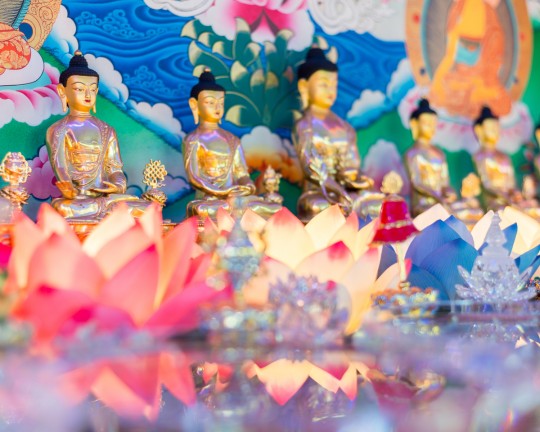
Detailed photo of one of Lama Zopa Rinpoche’s altars at Kachoe Dechen Ling, California, US. Photo by Chris Majors.
“On the way to Mongolia in August 2014, Rinpoche stayed in a Seattle Washington hotel overnight in the United States,” said Ven. Holly Ansett, executive assistant to FPMT International Office’s CEO and FPMT Charitable Projects coordinator. “The first thing Rinpoche does when entering a hotel is turn all the lights on and begins extensive offering practice. In the morning, before leaving for the airport, Rinpoche left a five-dollar tip for the cleaning lady and a small note written on the hotel’s comment card:”
I had so much worldly pleasure here, so much sleep. What I did is I blessed all the light offerings in the room and I offered them to Guru, Buddha, Dharma, Sangha and I rejoiced in all the merits of the buddhas and bodhisattvas and all beings, and I did three prostrations – two I did full length and one I did half length – on the bed, because I had a stroke a few years ago. So this is what I did to make useful the money spent staying here. Thank you.
I dedicated for you to have a long life and to be healthy and for all your wishes to succeed according to the Dharma, to have an ethical mind and pure mind.
With much love and prayers
Lama Zopa
Scribed by Ven. Holy Ansett, Seattle, Washington, US, August 2014. Lightly edited for Mandala.
“Extensive Offering Practices to Accumulate the Most Extensive Merit,” Lama Zopa Rinpoche’s compilation of offering practices – including Lama Atisha’s “Light Offering Practice” – and commentary is available through the Foundation Store.
More information, photos and updates about FPMT spiritual director Lama Zopa Rinpoche can be found on Rinpoche’s webpage. If you’d like to receive news of Lama Zopa Rinpoche via email, sign up to Lama Zopa Rinpoche News.
- Tagged: lama zopa rinpoche, offerings
- 0
10
Can Negative Actions Have Positive Results?
Lama Zopa Rinpoche came to the 4 p.m. session of the Australia retreat on Thursday, October 9, for a question and answer session led by Ven. Sarah Thresher. She asked Rinpoche about the karma of the bodhisattva captain who killed 500 people on a boat. According to Ven. Holly Ansett, “Rinpoche gave an incredible response that included the whole history of the FPMT – how it started from the Kachen Yeshe Gyaltsen text that Rinpoche was reading. Rinpoche also told some incredibly personal stories about his own practice.”
You can watch the video of the teaching on FPMT’s Livestream page.
https://new.livestream.com/accounts/2729219/events/3329712/videos/64382400/player?width=560&height=315&autoPlay=false&mute=false
At the end of the session, Rinpoche gave refuge to a few people who were leaving the retreat.
“The processions leading Rinpoche to the Great Stupa of Universal Compassion each day are becoming more and more amazing,” Ven. Holly reports. “Usually about 30-40 people lead Rinpoche slowly down to the gompa, each person holding an offering object, flowers, incense, auspicious symbols, playing ting-shas or cymbals, walking very slowly, aware of the ants and leading Rinpoche to the Great Stupa’s gompa to continue the oral transmission of the Golden Light Sutra.”
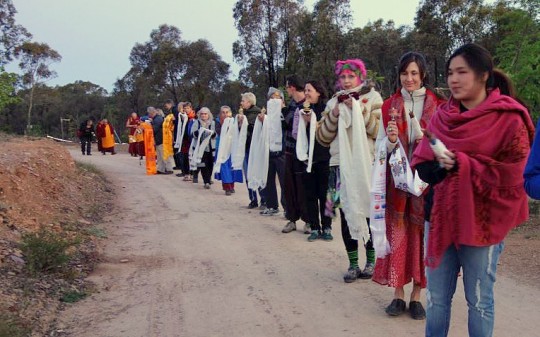
Procession leading Lama Zopa Rinpoche to gompa at Great Stupa of Universal Compassion, Australia, October 2014. Photo by Ven. Roger Kunsang.
More information, photos and updates about FPMT spiritual director Lama Zopa Rinpoche can be found on Rinpoche’s webpage. If you’d like to receive news of Lama Zopa Rinpoche via email, sign up to Lama Zopa Rinpoche News.
- Tagged: australia retreat 2014, lama zopa rinpoche, video
- 0
9
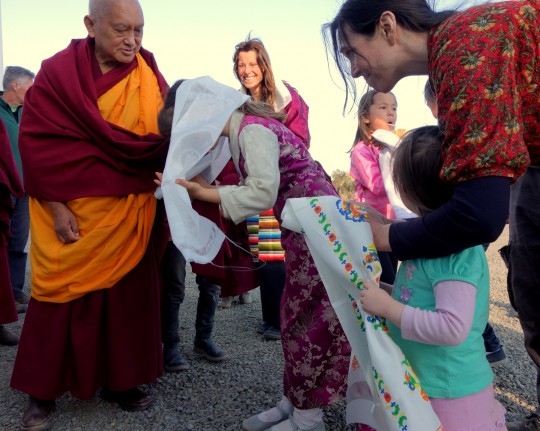
Lama Zopa Rinpoche giving blessing to children after the long life puja, Great Stupa of Universal Compassion, Australia, September 19, 2014. Photo by Ven. Roger Kunsang.
Lama Zopa Rinpoche taught on bring up children during the October 8 teaching session of the ongoing retreat in Australia. You can watch the video of the teaching on FPMT’s Livestream page.
https://new.livestream.com/accounts/2729219/events/3329712/videos/64296600/player?width=560&height=315&autoPlay=false&mute=false
That evening in Australia was a lunar eclipse that was fully visible over the Great Stupa of Universal Compassion, where the retreat is taking place. Rinpoche did intense prayers during the eclipse time from the second it started until it finished about 3 or 4 hours later.
Rinpoche sent a message to all the retreatants, reminding them that any merit created during an eclipse period is multiplied 100,000 times and that it is a very powerful time to do practice as the eclipse affects the winds in the body. Rinpoche said he checked many times and it came out for the retreatants to recite “King of Prayers” three times, “A Prayer for the Beginning, Middle, and End of Practice” by Je Tsongkhapa once and then to have one person recite the Heart Sutra slowly, pausing often so that others can strongly meditate on it.
Learn more about Lama Zopa Rinpoche, spiritual director of the Foundation for the Preservation of Mahayana Tradition (FPMT), and Rinpoche’s vision for a better world. Sign up to receive news and updates.
- Tagged: australia retreat 2014, children, lama zopa rinpoche, video
- 0
7
Lama Atisha and the Lam-rim
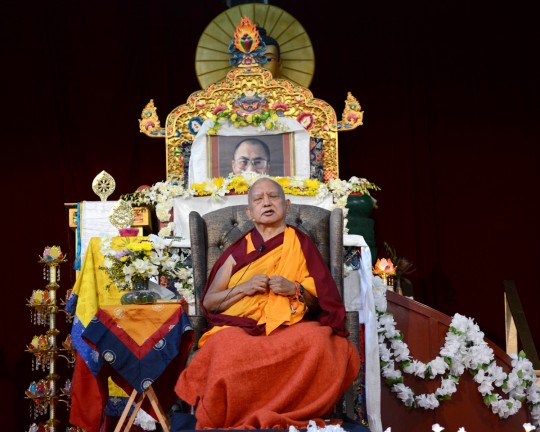
Lama Zopa Rinpoche during the public talk at the Great Stupa of Universal Compassion, Bendigo, Australia, September 20, 2014. Photo by Kunchok Gyaltsen.
When Lama Atisha went to Tibet, he was told about all the problems there, Lama Zopa Rinpoche recounted during the public teaching at the Great Stupa of Universal Compassion on September 20, 2014. “Then Lama Atisha wrote a text integrating all Buddha’s teachings into a few pages,” Rinpoche said. “It is called Lamp of the Path to Enlightenment. The text was sent to India to be checked. The pandits were so surprised. At that time if a text had mistakes, they would tie it on the tail of a dog and it would be taken around the city. At that time they did like that, but they were so surprised that Lama Atisha had integrated all Buddha’s teachings in the three pages of the Lamp of the Path to Enlightenment, the graduated path to enlightenment — the name started from this text — so graduated path of lower capable being, graduated path of middle capable being, and graduated path of higher capable being. So all the Buddha’s teachings are in those three, embodied in the lam-rim, the graduated path to enlightenment.
“The graduated path of lower capable being, oh, that one is to not harm others, that instruction goes: do not harm others. Then the graduated path of middle capable being, oh, that teaching is also to not harm others, mainly it is to not harm others. Now the teaching of graduated path of higher capable being is to benefit others. So lam-rim, what Lama Atisha wrote, all the Buddha’s teachings comes down to not harming others and benefiting others. The right view of Buddhism is dependent arising and the action is to not harm others. That is included in Lama Atisha’s teachings, everything is included there: to not harm others and to benefit others.”
You can watch a video of this teaching on FPMT’s Livestream page.
https://new.livestream.com/accounts/2729219/events/3332581/videos/62561679/player?width=560&height=315&autoPlay=false&mute=false
Quote taken from the transcript by Ven. Joan Nicell of Lama Zopa Rinpoche’s public talk at the Great Stupa of Universal Compassion, Bendigo, Australia, September 20, 2014. Lightly edited by Mandala.
More information, photos and updates about FPMT spiritual director Lama Zopa Rinpoche can be found on Rinpoche’s webpage. If you’d like to receive news of Lama Zopa Rinpoche via email, sign up to Lama Zopa Rinpoche News.
- Tagged: advice, lam-rim, lama zopa rinpoche
- 0
7
Lama Zopa Rinpoche, through the Lama Zopa Rinpoche Bodhichitta Fund, recently offered US$50,000 toward a new place for His Holiness the Dalai Lama to stay when in Bylakuppe, India. This new accommodation is being built by the Tibetan Settlement Office in Bylakuppe.
Please rejoice that FPMT is able to offer service to His Holiness, in this way.
Recently, Lama Zopa Rinpoche composed a beautiful prayer, “Remembering the Kindness of His Holiness the Dalai Lama and the Tibetan People.”
You are welcome to donate any amount to the Lama Zopa Rinpoche Bodhichitta Fund toward the cost of this offering.
You can learn more about the Lama Zopa Rinpoche Bodhichitta Fund as well as the other Charitable Projects of FPMT.
6
Lama Zopa Rinpoche ‘Keeps Us On Our Toes’
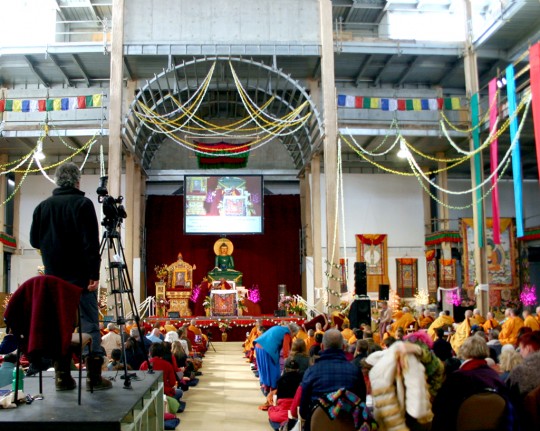
Lama Zopa Rinpoche teaching during the retreat in Australia at the Great Stupa of Universal Compassion, October 2014. Photo by Cynthia Karena.
Friday, October 3, was a tsog day and at the Australia retreat, Lama Zopa Rinpoche attended the 9 a.m. session and offered tsog with all the retreat participants in the gompa of the Great Stupa of Universal Compassion. Three senior monks went up and made the tsog offering to Rinpoche.
Rinpoche then taught about the 10 benefits of the Offering Cloud mantra and gave a very short commentary on the Song of Spring Queen, which you can watch on video.
https://new.livestream.com/accounts/2729219/events/3329712/videos/63780242/player?width=560&height=315&autoPlay=false&mute=false
Ven. Robina Courtin is attending the retreat and shared on her Facebook page, “Glad to be here at Atisha Buddhist Centre Bendigo and the Great Stupa for Lama Zopa Rinpoche’s retreat, along with the other 250 people. Rinpoche is scheduled to come at 4 p.m., but so far by now, the eighth day, he’s been here morning, noon, and night. Masses of instructions, and much laughter — but Rinpoche’s also so much more fierce these days! Keeps us on our toes.”
Live webcasts and recording of all the daily sessions with Lama Zopa Rinpoche at the retreat in Australia can be watched on the FPMT Livestream page. Audio MP3 recordings of the retreat sessions with Rinpoche are available for download with translation into French, Italian and Spanish.
Lama Zopa Rinpoche is the spiritual director of the Foundation for the Preservation of Mahayana Tradition (FPMT), a Tibetan Buddhist organization dedicated to the transmission of the Mahayana Buddhist tradition and values worldwide through teaching, meditation and community service.
- Tagged: australia retreat 2014, lama zopa rinpoche
- 0
5
Lama Zopa Rinpoche at the Great Stupa of Universal Compassion [Video]
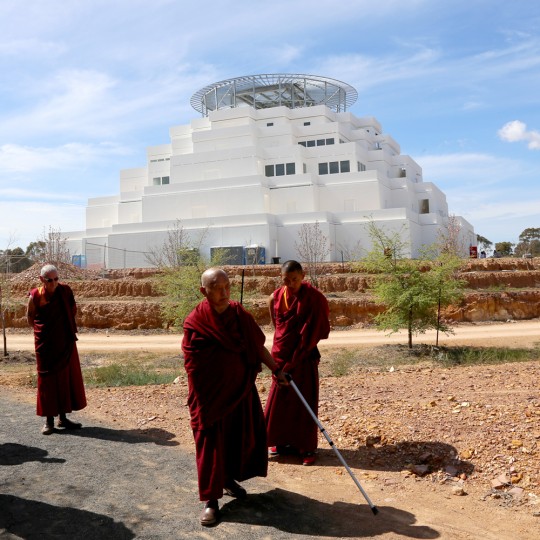
Lama Zopa Rinpoche and the Great Stupa of Universal Compassion, Australia, September 2014. Photo by Ven. Thubten Kunsang.
During the ongoing retreat in Australia, Lama Zopa Rinpoche has been teaching in the unfinished gompa at the Great Stupa of Universal Compassion. The Great Stupa, modeled on the stupa at Gyantse, Tibet, is one of three FPMT centers in the Bendigo, Victoria, area. (The others are Atisha Centre and Thubten Shedrup Ling Monastery.)
The inspiring story of the stupa’s creation, which started as an idea drawn in the sand by Lama Yeshe, illustrates how a lama’s vision can be brought to life. Mandala April-June 2014 featured an article on the progress that has been made on the the Great Stupa in the last few years. Ian Green, who serves as director of the Great Stupa, has been the primary driving force of the project since its inception. You can read an interview with Ian Green from 2011 about how he came to be involved. Ian also talks about the Jade Buddha of Universal Peace, another large holy object that he’s helped create, which will eventually find its permanent home in the Great Stupa.
To get a sense of the scale of the Great Stupa, you can watch this short new video of the site taken in September 2014 and released this week. And you can rejoice in this amazing project!
You can read more stories from Mandala about the Great Stupa and the Jade Buddha online.
Live webcasts and recording of all the daily sessions with Lama Zopa Rinpoche at the retreat in Australia can be watched on the FPMT Livestream page. Audio MP3 recordings of the retreat sessions with Rinpoche are available for download with translation into French, Italian and Spanish.
Learn more about Lama Zopa Rinpoche, spiritual director of the Foundation for the Preservation of Mahayana Tradition (FPMT), and Rinpoche’s vision for a better world. Sign up to receive news and updates.
3
A Long, Slow Procession Leads Lama Zopa Rinpoche to the Gompa
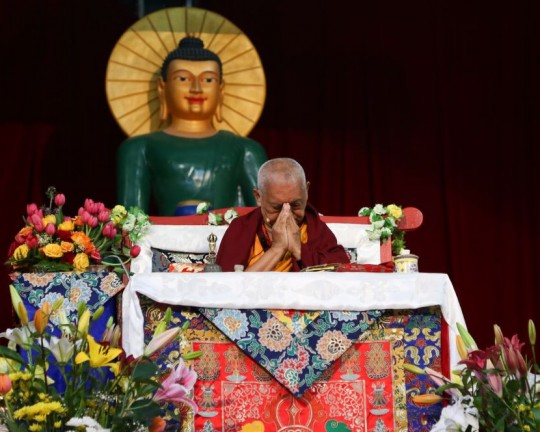
Lama Zopa Rinpoche during retreat at Great Stupa of Universal Compassion, Australia, October 2014. Photo by Ven. Thubten Kunsang.
On Wednesday, October 1, about 40 center directors and spiritual program coordinators (SPCs) from FPMT centers, projects and services around the world led FPMT spiritual director Lama Zopa Rinpoche from Thubten Shedrup Ling Monastery to the gompa in the Great Stupa of Universal Compassion, where Rinpoche continued to give the extraordinary oral transmission of the Golden Light Sutra at the Bodhicaryavatara and Rinjung Gyatsa retreat.
Rinpoche said that the oral transmission of the 21 Chapter Golden Light Sutra that he is giving is an incredible puja for the whole world. Rinpoche explained earlier in the week that even people watching as the video recording can take it as an oral transmission. (You can find the text of the Golden Light Sutra in 14 different languages here.)
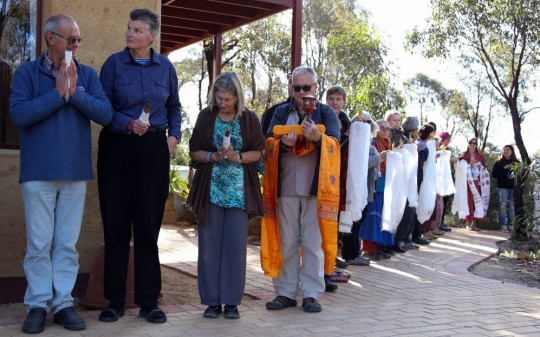
About 40 directors and SPC from FPMT centers, projects and services lined up to lead Rinpoche from Thubten Shedrup Ling Monastery to the Great Stupa to continue the oral transmission of the Golden Light Sutra, Australia, October 2014. Photo by Ven. Thubten Kunsang.
Everyone in the long procession held an offering — incense, one of the auspicious offerings, flowers, or playing cymbals or conchs. “It was a very beautiful, slow procession,” Ven. Holly Ansett shared. “The procession is because in the Golden Light Sutra it actually says that however many steps you walk to invite the lama who gives the oral transmission of Golden Light Sutra, you create that many causes of enlightenment.”
In the evening session on October 1, Rinpoche gave a brief commentary on Lama Chopa. Rinpoche attended the 6 a.m. and 9 a.m. sessions on October 2. He continued his commentary on Lama Chopa in the 9 a.m. session, which you can watch online.
https://new.livestream.com/accounts/2729219/events/3329712/videos/63701000/player?width=560&height=315&autoPlay=false&mute=false
Live webcasts and recording of all the daily sessions with Lama Zopa Rinpoche at the retreat in Australia can be watched on the FPMT Livestream page. Audio MP3 recordings of the retreat sessions with Rinpoche are available for download with translation into French, Italian and Spanish.
Lama Zopa Rinpoche is the spiritual director of the Foundation for the Preservation of Mahayana Tradition (FPMT), a Tibetan Buddhist organization dedicated to the transmission of the Mahayana Buddhist tradition and values worldwide through teaching, meditation and community service.
3
What Is Inside
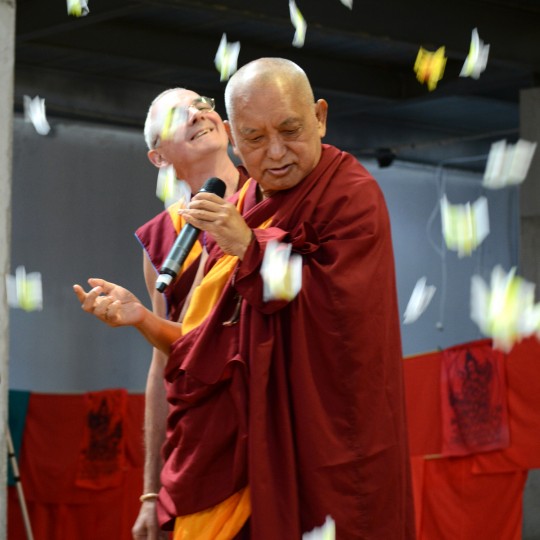
Flowers falling from above on Lama Zopa Rinpoche and Ven. Roger Kunsang following the public talk with Rinpoche, Great Stupa of Universal Compassion, Australia, September 20, 2014. Photo by Kunchok Gyaltsen.
“Lama Zopa: The great peace and happiness comes from inside. The real enemy is inside … Attachment to worldly pleasures of this life.”
– From Ven. Roger Kunsang’s Twitter page, posted on October 1, 2014,
during Bodhicaryavatara and Rinjung Gyatsa retreat.
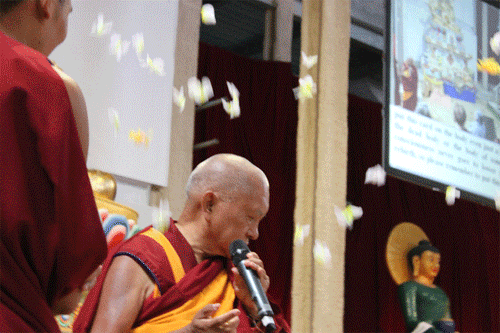
Lama Zopa Rinpoche and flower falling from above, Great Stupa of Universal Compassion, Australia, September 20, 2014. Photos by Tom Truty.
Ven. Roger Kunsang, Lama Zopa Rinpoche’s assistant and CEO of FPMT Inc., shares Lama Zopa Rinpoche’s recent pith sayings on Ven. Roger’s Twitter page. (You can also read them on Ven. Roger’s Facebook page.)
Live webcasts and recording of all the daily sessions with Lama Zopa Rinpoche at the retreat in Australia can be watched on the FPMT Livestream page. Audio MP3 recordings of the retreat sessions with Rinpoche are available for download with translation into French, Italian and Spanish.
More information, photos and updates about FPMT spiritual director Lama Zopa Rinpoche can be found on Rinpoche’s homepage. If you’d like to receive news of Lama Zopa Rinpoche via email, sign up to Lama Zopa Rinpoche News.
- Tagged: australia retreat 2014, lama zopa rinpoche, twitter
- 0
2
Benefiting the ‘Darling Ants’
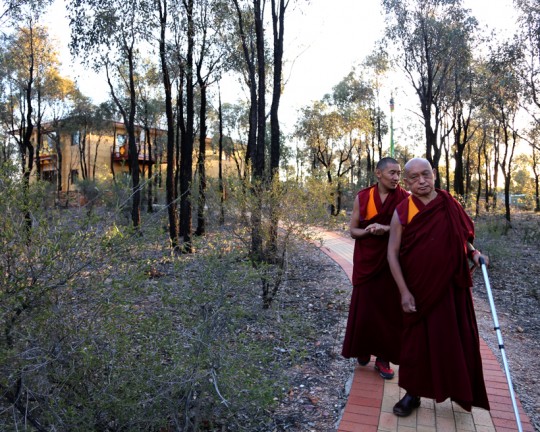
Lama Zopa Rinpoche with Ven. Sangpo on brick path from Thubten Shedrup Ling Monastery to Great Stupa of Universal Compassion, Australia, September 2014. Photo by Ven. Thubten Kunsang.
Lama Zopa Rinpoche has been staying at Thubten Shedrup Ling Monastery very near the Great Stupa of Universal Compassion while leading the Bodhicaryavatara and Rinjung Gyatsa retreat. Ven. Holly Ansett, who is at the retreat, recently reported, “A few nights ago when walking back from the stupa in the evening, one ant was mistakenly injured on the path. Rinpoche spent about 10 minutes reciting mantras and blowing on the ant. When he got back to the room, Rinpoche was visibly upset about the ant, requesting that immediately four stupas be made and dedicated for the ant. So we requested Ven. Anet, the nun at Kachoe Dechen Ling in California who makes tsa-tsas, to immediately make the stupas and fill them with the four dharmayaka relic mantras and dedicate that for the ant. Then before dinner, Rinpoche recited ‘A Prayer for the Beginning, Middle, and End of Practice’ by Je Tsongkhapa, which is a prayer to meet Lama Tsongkhapa’s teachings, and dedicated for the ant.
“This evening,” Ven. Holly continued, “Rinpoche called out ‘darling ant’ every time he encountered an ant on the path to indicate to others to be careful not to tread on the ant. So all the way up to the monastery, Rinpoche was yelling out ‘darling ant.’ It was extremely precious and sweet.”
Live webcasts and recording of all the daily sessions with Lama Zopa Rinpoche at the retreat in Australia can be watched on the FPMT Livestream page. Audio MP3 recordings of the retreat sessions with Rinpoche are available for download with translation into French, Italian and Spanish.
Lama Zopa Rinpoche is the spiritual director of the Foundation for the Preservation of Mahayana Tradition (FPMT), a Tibetan Buddhist organization dedicated to the transmission of the Mahayana Buddhist tradition and values worldwide through teaching, meditation and community service.
1
Lama Zopa Rinpoche on Lama Chöpa Jorchö
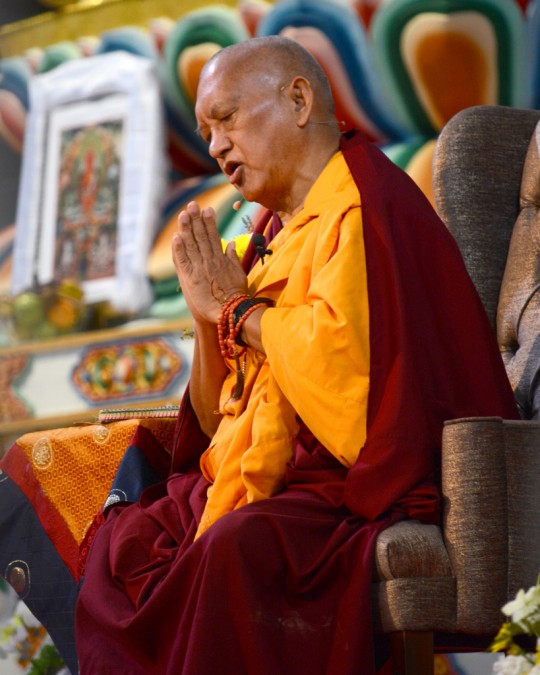
Lama Zopa Rinpoche teaching at Great Stupa of Universal Compassion for long life puja, Australia, September 19, 2014. Photo by Kunchok Gyaltsen.
On the second day of the Bodhicaryavatara and Rinjung Gyatsa retreat with Lama Zopa Rinpoche, Rinpoche attended the 9 a.m. session for Lama Chöpa Jorchö. You can watch a video recording of most of the Lama Chöpa Jorchö with Rinpoche. At the end of the practice, Rinpoche gave some advice about specific tunes and what’s most essential to think when doing the Lama Thubwang Dorje Chang prayer at the end. Rinpoche also praised Ven. Tenzin Tsapel, resident teacher at Golden Light Sutra Center in Mongolia, for her beautiful chanting of the tunes as she led the puja.
Live webcasts and recording of all the daily sessions with Lama Zopa Rinpoche at the retreat in Australia can be watched on the FPMT Livestream page. Audio MP3 recordings of the retreat sessions with Rinpoche are available for download with translation into French, Italian and Spanish.
Lama Zopa Rinpoche is the spiritual director of the Foundation for the Preservation of Mahayana Tradition (FPMT), a Tibetan Buddhist organization dedicated to the transmission of the Mahayana Buddhist tradition and values worldwide through teaching, meditation and community service.
- Tagged: jorcho, lama chopa, lama zopa rinpoche
- 0
- Home
- News/Media
- Study & Practice
- About FPMT Education Services
- Latest News
- Programs
- New to Buddhism?
- Buddhist Mind Science: Activating Your Potential
- Heart Advice for Death and Dying
- Discovering Buddhism
- Living in the Path
- Exploring Buddhism
- FPMT Basic Program
- FPMT Masters Program
- FPMT In-Depth Meditation Training
- Maitripa College
- Lotsawa Rinchen Zangpo Translator Program
- Universal Education for Compassion & Wisdom
- Online Learning Center
- Prayers & Practice Materials
- Overview of Prayers & Practices
- Full Catalogue of Prayers & Practice Materials
- Explore Popular Topics
- Benefiting Animals
- Chenrezig Resources
- Death & Dying Resources
- Lama Chopa (Guru Puja)
- Lama Zopa Rinpoche: Compendium of Precious Instructions
- Lama Zopa Rinpoche: Life Practice Advice
- Lama Zopa Rinpoche Practice Series
- Lamrim Resources
- Mantras
- Prayer Book Updates
- Purification Practices
- Sutras
- Thought Transformation (Lojong)
- Audio Materials
- Dharma Dates – Tibetan Calendar
- Translation Services
- Publishing Services
- Teachings and Advice
- Find Teachings and Advice
- Lama Zopa Rinpoche Advice Page
- Lama Zopa Rinpoche: Compendium of Precious Instructions
- Lama Zopa Rinpoche Video Teachings
- ༧སྐྱབས་རྗེ་བཟོད་པ་རིན་པོ་ཆེ་མཆོག་ནས་སྩལ་བའི་བཀའ་སློབ་བརྙན་འཕྲིན།
- Podcasts
- Lama Yeshe Wisdom Archive
- Buddhism FAQ
- Dharma for Young People
- Resources on Holy Objects
- Ways to Offer Support
- Centers
- Teachers
- Projects
- Charitable Projects
- Make a Donation
- Applying for Grants
- News about Projects
- Other Projects within FPMT
- Support International Office
- Projects Photo Galleries
- Give Where Most Needed
- FPMT
- Shop
Translate*
*powered by Google TranslateTranslation of pages on fpmt.org is performed by Google Translate, a third party service which FPMT has no control over. The service provides automated computer translations that are only an approximation of the websites' original content. The translations should not be considered exact and only used as a rough guide.If your path teaches you to act and exert yourself correctly and leads to spiritual realizations such as love, compassion and wisdom then obviously it’s worthwhile.







